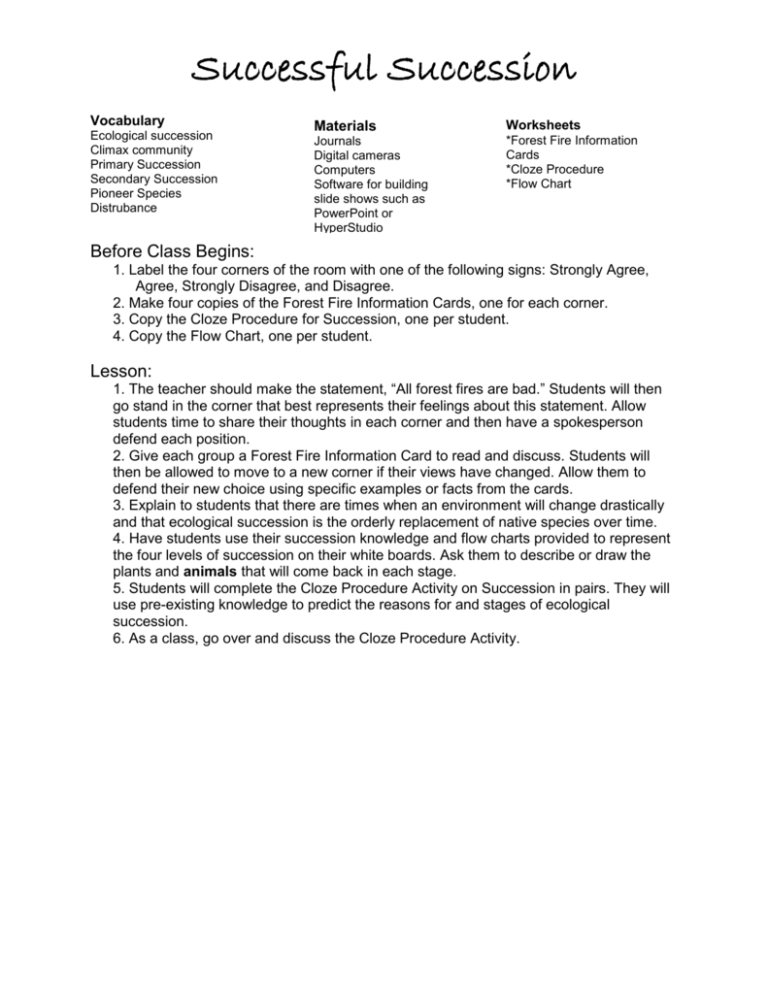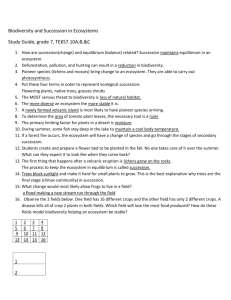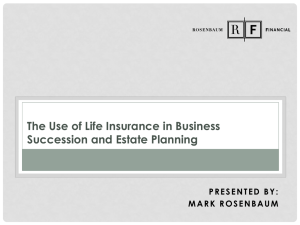Successful Succession
advertisement

Successful Succession Vocabulary Ecological succession Climax community Primary Succession Secondary Succession Pioneer Species Distrubance Materials Worksheets Journals Digital cameras Computers Software for building slide shows such as PowerPoint or HyperStudio *Forest Fire Information Cards *Cloze Procedure *Flow Chart Before Class Begins: 1. Label the four corners of the room with one of the following signs: Strongly Agree, Agree, Strongly Disagree, and Disagree. 2. Make four copies of the Forest Fire Information Cards, one for each corner. 3. Copy the Cloze Procedure for Succession, one per student. 4. Copy the Flow Chart, one per student. Lesson: 1. The teacher should make the statement, “All forest fires are bad.” Students will then go stand in the corner that best represents their feelings about this statement. Allow students time to share their thoughts in each corner and then have a spokesperson defend each position. 2. Give each group a Forest Fire Information Card to read and discuss. Students will then be allowed to move to a new corner if their views have changed. Allow them to defend their new choice using specific examples or facts from the cards. 3. Explain to students that there are times when an environment will change drastically and that ecological succession is the orderly replacement of native species over time. 4. Have students use their succession knowledge and flow charts provided to represent the four levels of succession on their white boards. Ask them to describe or draw the plants and animals that will come back in each stage. 5. Students will complete the Cloze Procedure Activity on Succession in pairs. They will use pre-existing knowledge to predict the reasons for and stages of ecological succession. 6. As a class, go over and discuss the Cloze Procedure Activity. Successful Succession In the Field Prior to leaving the school, make sure you have: • Digital cameras • Journals • Pens or pencils • First Aid Kit In the forest, students will be observing different stages of succession. Guide students to a variety of locations within the forest that are examples of different stages of succession. In each area, allow students enough time to observe and record data regarding the plants and animals in that location. They should take pictures of each area and record observations in their journals. Successful Succession Class Activities Students will use the pictures and recorded data made in the forest to create an oral presentation on ecological succession. This presentation should include examples of e stages of succession as well as information regarding the role of succession in the rest environment. A sample rubric for grading follows: RUBRIC VISUAL ELEMENTS Minimum of 10 slides Pictures of 4 stages of succession 20 points 20 points NARRATIVE ELEMENTS Evidence to support the four stages Discussion of the role of succession 20 points 20 points PRESENTATION STYLE 20 points TOTAL 100 POINTS Successful Succession Forest Fire Information Cards Forest fires: • clear the way for new growth by opening the forest canopy for sunlight. • cost over $600 million per year. • cover the ground with ash that is rich in calcium, phosphorus and other minerals. • can enhance natural wildlife habitats. • can control insect population and disease. • clear undergrowth reducing the probability of future fires. • allow some trees to get the intense heat needed to open their cones and release seeds. • endanger homes, property, and human life. • are used to clear a logged area for planting of new trees. • can destroy natural wildlife habitats. Forest Fire Information Cards Forest fires: • clear the way for new growth by opening the forest canopy for sunlight. • cost over $600 million per year. • cover the ground with ash that is rich in calcium, phosphorus and other minerals. • can enhance natural wildlife habitats. • can control insect population and disease. • clear undergrowth reducing the probability of future fires. • allow some trees to get the intense heat needed to open their cones and release seeds. • endanger homes, property, and human life. • are used to clear a logged area for planting of new trees. • can destroy natural wildlife habitats. Successful Succession Successful Succession STAGE ONE STAGE TWO STAGE THREE STAGE FOUR Successful Succession STAGE ONE Grasses and weeds grow and scatter seeds. Insects, worms, and birds return. Lasts about 5 years STAGE TWO Dense shrubs, vines, and non-woody, short plants Rabbits, snakes, skunks Lasts about 10 years STAGE THREE Pine and other fast-growing trees Owl, squirrels, foxes STAGE FOUR Hardwood trees Climax community Many species of plants and animals Successful Succession CLOZE PROCEDURE NOTE: This answer key contains possible answers for each blank. There are other viable choices for many of the blanks. Occasionally a forest environment can be destroyed by natural disasters such is fires, diseases, floods or the actions of humans. When the plants are destroyed, many animals lose their habitat. However, some animals are able to survive by leaving the area or burrowing under ground. Succession is a term used to describe a type of natural regrowth that occurs in these situations. In the first stage of succession, grasses and weeds begin to grow and scatter seeds, Insects, worms, and birds begin to return. This stage lasts about five years. As these plants die and decay, valuable nutrients are added to the soil. This fertile ground enables the shrubs, vines, and other non-woody plants to flourish. Animals such as rabbits, snakes, and skunks find shelter in this ground cover. This simple environment continues for about ten years. As the soil deepens, pine and other fast-growing trees spring up, providing habitat for animals such as owls and squirrels. The trees also block sunlight to the shrubs and vines below. The decay of those plants further deepens the soil. In the last stage, hardwood trees such as oak and hickory grow. They eventually replace the pine trees. The dead pine trees provide homes for many animals as well as mosses and mushrooms. Unless it is destroyed by another natural disaster or human intervention, there will be no more changes in this habitat. A community that does not undergo further succession is called a climax community. Successful Succession CLOZE PROCEDURE Use your current knowledge of nature and the forest environment to fill in the blanks below. Occasionally a forest environment can be destroyed by natural ________ such is fires, ________, ________ or the actions of ________. When the ________ are destroyed, many animals lose their ________. However, some animals are able to survive by leaving the area or burrowing under ground. ________ is a term used to describe a type of natural regrowth that occurs in these situations. In the first stage of succession, ________ and ________ begin to grow and scatter ________, ________, ________, and ________ begin to return. This stage lasts about ________ years. As these plants die and ________, valuable ________ are added to the soil. This fertile ground enables the ________, ________, and other ________plants to flourish. Animals such as ________, ________, and ________ find shelter in this ground cover. This simple environment continues for about ________ years. As the soil deepens, ________ and other fast-growing trees spring up providing ________ for animals such as ________ and ________. The trees also block ________ to the shrubs and vines below. The ________ of those plants further deepens the ________. In the last stage, ________ trees such as oak and hickory grow. They eventually replace the pine trees. The dead pine trees provide ________ for many animals as well as ________ and ________. Unless it is destroyed by another ________ ________ or human intervention, there will be no more ________ in this habitat. A community that does not undergo further ________is called a climax community.








